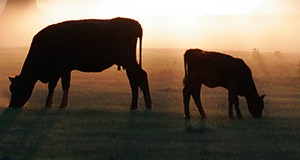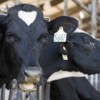 To perform a fetotomy means to dissect (to cut apart) a dead fetus in utero. Fetotomy is applicable particularly to cows because of the size of the uterus and the opportunity to introduce instruments to the full depth of the fetus. Fetotomy is an obstetric procedure that should only be performed by a trained veterinarian or under a trained veterinarian’s supervision. This 4-page fact sheet lists the circumstances when a fetotomy can be performed to save the life of the dam, the tools needed, fetotome preparation, the sequence of cuts for anterior presentation, and final comments. Written by Myriam Jimenez, Carlos Risco, and Klibs N. Galvão, and published by the UF Department of Veterinary Medicine-Large Animal Clinical Sciences, August 2015.
To perform a fetotomy means to dissect (to cut apart) a dead fetus in utero. Fetotomy is applicable particularly to cows because of the size of the uterus and the opportunity to introduce instruments to the full depth of the fetus. Fetotomy is an obstetric procedure that should only be performed by a trained veterinarian or under a trained veterinarian’s supervision. This 4-page fact sheet lists the circumstances when a fetotomy can be performed to save the life of the dam, the tools needed, fetotome preparation, the sequence of cuts for anterior presentation, and final comments. Written by Myriam Jimenez, Carlos Risco, and Klibs N. Galvão, and published by the UF Department of Veterinary Medicine-Large Animal Clinical Sciences, August 2015.
http://edis.ifas.ufl.edu/vm224
Tag: Veterinary Medicine: Dairy
Comparing the Urine Ketone Strip Test and Handheld Ketone Meter to Diagnose Ketosis in Early Lactation Dairy Cows (VM186)
 Ketosis is a common metabolic disease in fresh dairy cows. Clinical and subclinical ketosis (SCK) can cause reduced milk yield, decreased milk protein, reduced reproductive capacity, and increased risk of displaced abomasum. Usually, diagnosing ketosis is performed by measuring acetoacetate or BHBA levels in the blood, urine, or milk samples. Measuring BHBA in serum or plasma is considered the gold standard diagnostic test for subclinical ketosis, because this method has stability, but the price for ketone strips is approximately $0.08/strip while the price for the the electronic BHBA measuring system is approximately $1.00. UF/IFAS researchers conducted a study to compare the two, using 72 Holstein cows between 14–40 days in milk from three dairy farms in north-central Florida with 450–800 lactating dairy cows. The key finding for this experiment is that no difference exists in BHBA concentration between cows that had a trace or small in the ketone strip reading. This 3-page fact sheet was written by Klibs N. Galvão, Achilles Vieira Neto, Gustavo Peña, Joao Bittar, and Lucas Ibarbia, and published by the UF Department of Veterinary Medicine-Large Animal Clinical Sciences, October 2012.
Ketosis is a common metabolic disease in fresh dairy cows. Clinical and subclinical ketosis (SCK) can cause reduced milk yield, decreased milk protein, reduced reproductive capacity, and increased risk of displaced abomasum. Usually, diagnosing ketosis is performed by measuring acetoacetate or BHBA levels in the blood, urine, or milk samples. Measuring BHBA in serum or plasma is considered the gold standard diagnostic test for subclinical ketosis, because this method has stability, but the price for ketone strips is approximately $0.08/strip while the price for the the electronic BHBA measuring system is approximately $1.00. UF/IFAS researchers conducted a study to compare the two, using 72 Holstein cows between 14–40 days in milk from three dairy farms in north-central Florida with 450–800 lactating dairy cows. The key finding for this experiment is that no difference exists in BHBA concentration between cows that had a trace or small in the ketone strip reading. This 3-page fact sheet was written by Klibs N. Galvão, Achilles Vieira Neto, Gustavo Peña, Joao Bittar, and Lucas Ibarbia, and published by the UF Department of Veterinary Medicine-Large Animal Clinical Sciences, October 2012.
http://edis.ifas.ufl.edu/vm186
Use of Ultrasonography to Age Pregnancy in Early Gestation in Dairy Cows (VM184)
 Using ultrasonography for diagnosis and aging of pregnancy is becoming more widespread among bovine practitioners because it can be done earlier than by traditional methods, and because it can be used to monitor fetal development and determine fetal age and sex. This 3-page fact sheet presents a detailed measurement of the amniotic vesicle from 27 to 34 days after breeding so a more precise aging of early pregnancies can be performed. Written by Klibs N.A. Galvão, and published by the UF Department of Veterinary Medicine-Large Animal Clinical Sciences, May 2012.
Using ultrasonography for diagnosis and aging of pregnancy is becoming more widespread among bovine practitioners because it can be done earlier than by traditional methods, and because it can be used to monitor fetal development and determine fetal age and sex. This 3-page fact sheet presents a detailed measurement of the amniotic vesicle from 27 to 34 days after breeding so a more precise aging of early pregnancies can be performed. Written by Klibs N.A. Galvão, and published by the UF Department of Veterinary Medicine-Large Animal Clinical Sciences, May 2012.
http://edis.ifas.ufl.edu/vm184
Risk Factors for Uterine Disease in Dairy Cows (VM183)
 Uterine diseases are highly prevalent in high-producing dairy cows. Predictors of uterine disease include traditional risk factors, BHBA blood concentration, NEFA blood concentration, neutrophil glycogen stores and calcium. This 4-page fact sheet was written by Klibs N.A. Galvão, and published by the UF Department of Veterinary Medicine-Large Animal Clinical Sciences, May 2012.
Uterine diseases are highly prevalent in high-producing dairy cows. Predictors of uterine disease include traditional risk factors, BHBA blood concentration, NEFA blood concentration, neutrophil glycogen stores and calcium. This 4-page fact sheet was written by Klibs N.A. Galvão, and published by the UF Department of Veterinary Medicine-Large Animal Clinical Sciences, May 2012.
http://edis.ifas.ufl.edu/vm183
Uterine Microbiology of Healthy Cows and Cows That Develop Uterine Disease (VM182/)
 The dairy cow is unique because virtually all cows are infected with bacteria right after calving. A recent study that used metagenomic analysis to characterize the uterine flora in healthy and metritic cows observed that most clone sequences from the metritic cows were from the phylum Fusobacteria. This 4-page fact sheet summarizes what is known about the pathogenic bacteria associated with metritis and endometritis. Written by Klibs N. Galvão and published by the UF Department of Veterinary Medicine-Large Animal Clinical Sciences, January 2012.
The dairy cow is unique because virtually all cows are infected with bacteria right after calving. A recent study that used metagenomic analysis to characterize the uterine flora in healthy and metritic cows observed that most clone sequences from the metritic cows were from the phylum Fusobacteria. This 4-page fact sheet summarizes what is known about the pathogenic bacteria associated with metritis and endometritis. Written by Klibs N. Galvão and published by the UF Department of Veterinary Medicine-Large Animal Clinical Sciences, January 2012.
http://edis.ifas.ufl.edu/vm182
Association between Immune Function and Development of Uterine Disease in Dairy Cows (VM181)
 A sharp decrease in glucose and sodium during the transition to lactation makes dairy cows more susceptible to uterine disease. This 4-page fact sheet was written by Klibs N. Galvão, and published by the UF Department of Veterinary Medicine-Large Animal Clinical Sciences, January 2012.
A sharp decrease in glucose and sodium during the transition to lactation makes dairy cows more susceptible to uterine disease. This 4-page fact sheet was written by Klibs N. Galvão, and published by the UF Department of Veterinary Medicine-Large Animal Clinical Sciences, January 2012.
http://edis.ifas.ufl.edu/vm181